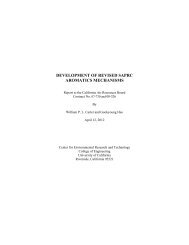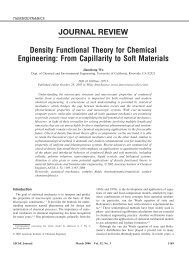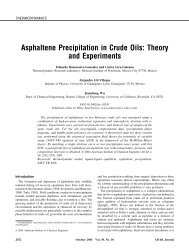Gas-Phase Ozone Oxidation of Monoterpenes: Gaseous and ...
Gas-Phase Ozone Oxidation of Monoterpenes: Gaseous and ...
Gas-Phase Ozone Oxidation of Monoterpenes: Gaseous and ...
Create successful ePaper yourself
Turn your PDF publications into a flip-book with our unique Google optimized e-Paper software.
GAS-PHASE OZONE OXIDATION OF MONOTERPENES 213<br />
2.4. RECOVERIES OF DENUDER AND FILTER SAMPLES<br />
Recoveries <strong>of</strong> select compounds were determined by spiking on filters <strong>and</strong> denuders<br />
known amounts <strong>of</strong> liquid st<strong>and</strong>ards <strong>and</strong> the recovery st<strong>and</strong>ard tricosane.<br />
The same extraction <strong>and</strong> concentration procedures as those described in Section 2.2<br />
were then applied. Relative recoveries for select multifunctional compounds versus<br />
the recovery st<strong>and</strong>ard tricosane are given in Table III. 2-Hydroxy-cyclohexanone<br />
is included to serve as a surrogate for hydroxy pina ketones <strong>and</strong> hydroxy sabina<br />
ketones, <strong>and</strong> the two dicarbonyls, 5-methyl-1,3-cyclohexanedione <strong>and</strong> 5-isopropyl-<br />
1,3-cyclohexanedione, act as surrogates for dicarbonyl compounds, such as pinonaldehyde<br />
<strong>and</strong> norpinonaldehyde. Two dicarboxylic acids, heptanedioic acid <strong>and</strong><br />
octanedioic acid, <strong>and</strong> one keto acid, 7-oxo-octanoic acid, are included to test<br />
whether compounds with the same type <strong>of</strong> functional groups exhibit similar recoveries.<br />
Comparison <strong>of</strong> the recoveries <strong>of</strong> heptanedioic <strong>and</strong> octanedioic acid with<br />
that <strong>of</strong> pinic acid, a C 9 cyclic dicarboxylic acid, shows that the three dicarboxylic<br />
acids exhibit similar recoveries for both denuder <strong>and</strong> filter samples. The two keto<br />
acids, 7-oxo-octanoic acid <strong>and</strong> pinonic acid, also have similar recoveries. This<br />
adds confidence to the assumption that the recoveries for those compounds without<br />
available st<strong>and</strong>ards can be approximated with those <strong>of</strong> known st<strong>and</strong>ards that have<br />
similar functional groups.<br />
For each compound tested, the denuder samples show lower recovery than filter<br />
samples. This indicates the mouth washing extraction technique performed on<br />
denuders is not as efficient in extracting the polar compounds as the soxhlet extraction<br />
method performed on filter samples. The large st<strong>and</strong>ard deviations associated<br />
with the recoveries are likely a result <strong>of</strong> a number <strong>of</strong> factors including extraction<br />
efficiency, volatilization during rotary evaporation, <strong>and</strong> losses from transfer <strong>and</strong><br />
surface adsorption. Absolute recovery <strong>of</strong> a given compound is obtained by multiplying<br />
its relative recovery by that <strong>of</strong> tricosane in individual samples. All the<br />
denuder <strong>and</strong> filter samples have been corrected with the recoveries determined here.<br />
3. Product Identification<br />
The newly developed analytical derivatization method (Yu et al., 1998) allows for<br />
detection <strong>and</strong> identification <strong>of</strong> three types <strong>of</strong> products: (1) those containing only<br />
carbonyl group(s) (e.g., simple aldehydes, ketones <strong>and</strong> dicarbonyls), (2) those containing<br />
only OH/COOH groups (e.g., dicarboxylic acids), <strong>and</strong> (3) those containing<br />
both carbonyl <strong>and</strong> OH/COOH groups (e.g., oxoacids <strong>and</strong> hydroxy carbonyls). Here<br />
OH/COOH denotes the presence <strong>of</strong> hydroxy or carboxy functional groups since the<br />
mass spectra for the TMS derivatives <strong>of</strong>ten can not differentiate between these two<br />
functional groups. Two types <strong>of</strong> ion chromatograms are constructed: m/z 181 ion<br />
chromatogram <strong>and</strong> m/z 73 <strong>and</strong> 75 ion chromatogram. Type (1) compounds show<br />
peaks only in the 181 ion chromatogram, type (2) compounds exhibit peaks only
















